Opinion
Against the ‘New Normal’: How Artists Are Responding to Terror and Tragedy With Alternative Media
In a culture oversaturated by violent imagery, can visual artists still make a point?
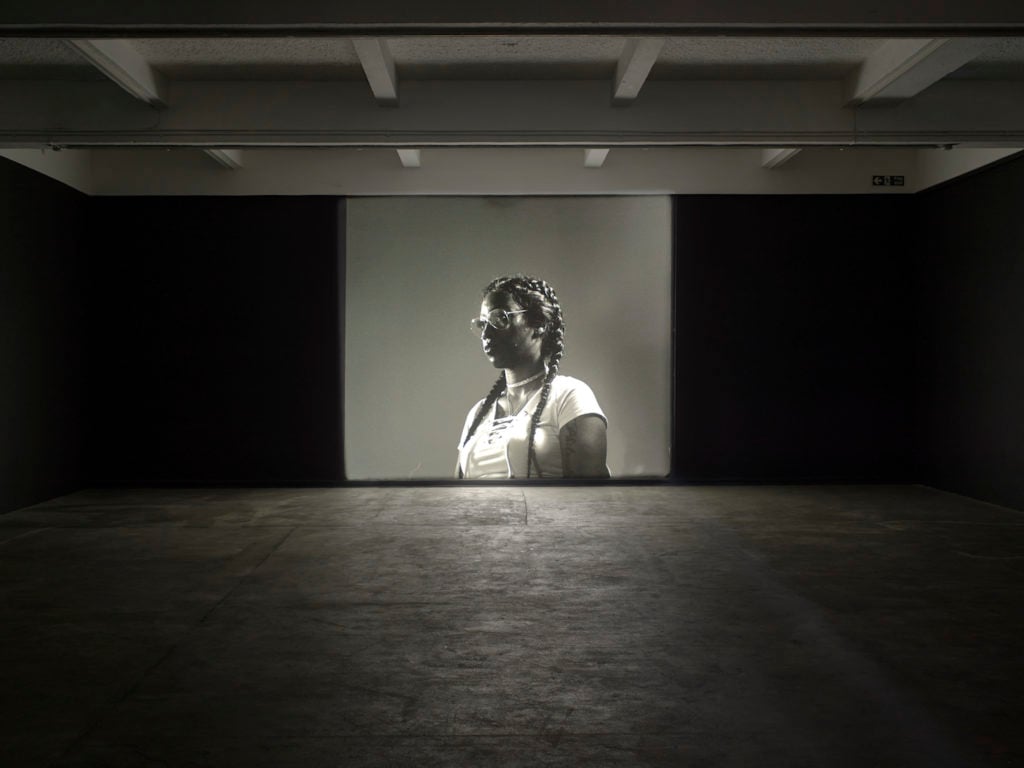
In a culture oversaturated by violent imagery, can visual artists still make a point?

Alice Bucknell

“What do pictures want?” writer and media theorist W. J. T. Mitchell asked the world a decade ago in his ground-breaking text of the same name. Writing from a post-9/11 perspective, Mitchell clocked a fundamental shift in our visual culture beginning in the early ’90s, where the jarring, violent imagery of the media was becoming the new normal. Fast forward 10 years, and we are deeply entangled within a web of financial crises, domestic and international terrorism, mass displacement, and environmental meltdown; the visual evidence of which is just as likely to appear within the infinite scroll of our Facebook feeds as in the morning news. But unlike news programming and the personalized newsstands of our social media, the art world has no express obligation to address world events as they unfold.
Yet this is starting to change. The wake-up call of Trump’s election, alongside the rapid rise of “alt-right” politics in the West, proves political turmoil is no longer a far-off concern reserved only for developing countries. Coupled with the largest migration of humankind since World War II and the dawn of the Anthropocene—the first geological era caused by human activity alone—this shifting world order has, to some extent, reset the boundaries between art and crisis. Take, for instance, New York’s 9/11 Museum, which last autumn launched its first art exhibition featuring work created in response to the tragedy; meanwhile, the Imperial War Museum in Southeast London is gearing up for “Age of Terror: Art Since 9/11“: the UK’s first exhibition to directly address the nature of contemporary art following the terrorist attack in 2001 and which will feature the work of Mona Hatoum, Ai Weiwei, Gerhard Richter, and Jenny Holzer, as part of its 2017 fall programming.
For the artists whose work delves into the visual language of crisis, this dance of ethics and aesthetics is one symptom of a much larger condition they must grapple with as a fundamental part of their practice. Within a culture that is so oversaturated by violent and traumatic imagery, how can art revive the arresting authority of the image, as Mitchell points out? What techniques or media are artists using to reboot our relationship to these pictures, and what happens when we finally let down our guard in order to see trauma, tragedy, and crisis for what it is? What new spaces for critical reflection will be possible to imagine together?
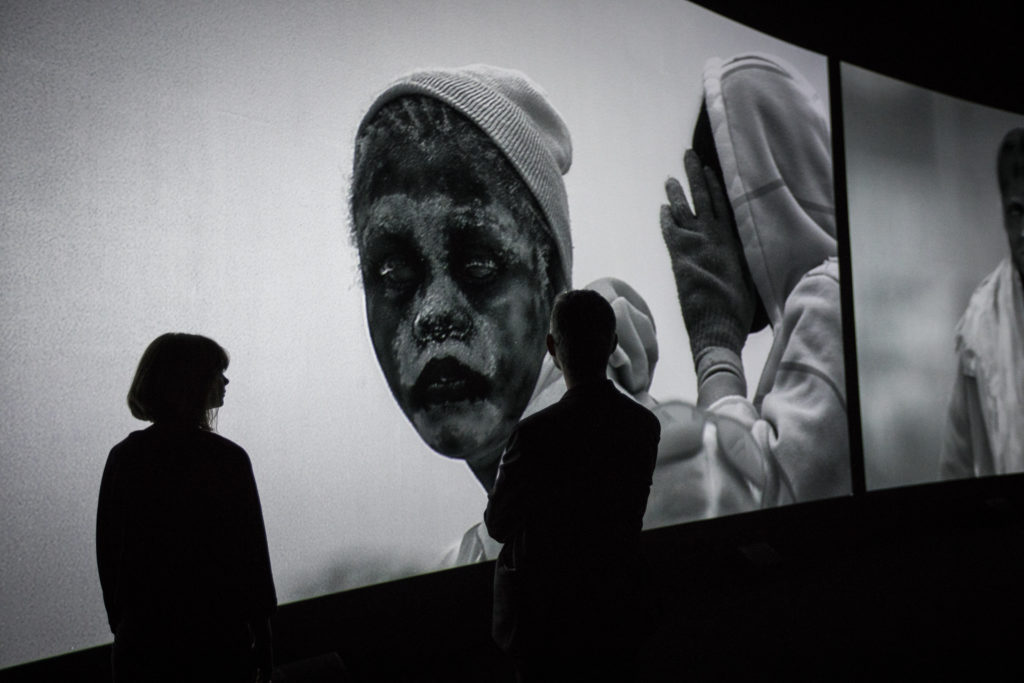
Richard Mosse in collaboration with Trevor Tweeten and Ben Frost, Incoming. Installation view at The Curve, Barbican Centre. Photo by Tristan Fewings/Getty images.
Today’s artists must work with the assumption that such violent and traumatic imagery has oversaturated our collective consciousness to the point of apathy. To counter this, artists are increasingly turning to the video installation format. With total control over both time and space, this getup has a world-making capacity: in the dark portal of the gallery, we lose control of the senses that ground us as viewers, and must recalibrate ourselves around the media the artist has introduced. In fact, 2017 has played host to a series of standout commissioned video installations—from Richard Mosse’s Incoming at London’s Barbican Art Gallery in London to Luke Willis Thompson’s autoportrait, produced in collaboration with Diamond Reynolds and shown at the Chisenhale Gallery in East London—that acutely process contemporary crisis in unconventional formats.
Within this, the proliferation of alternative media that today’s artists are using to address contemporary crisis is particularly significant. This includes a toolkit of obsolete, costly, illegal, or otherwise hard-to-find film and technology: such as Thompson’s use of high art-world sanctified Tri-X black-and-white film (a favourite of Warhol’s) or Mosse’s heat-sensor camera, intended for military use and able to target bodies at a distance of up to 35 kilometers. Long before this recent video install buzz, artists had tuned into the affective power of rare media to halt us in our tracks and force us to reconsider the visual language of trauma and crisis through an alternative lens. Standout still works like Adam Broomberg’s & Oliver Chanarin’s The Day Nobody Died (2008) indicate the power of large-scale analog photography, and more subversively, anti-photography.
Surveying these recent works by Broomberg & Chanarin, Mosse, and Thompson, we can see how today’s artists are utilizing such rare and codified media to both re-image and re-imagine crisis in unexpected ways, giving a new voice to the unspeakable acts of violence and trauma that frame our world at present. But we also see a deep divide between the competing desires to erase, fold into, and fight against the power of these images.
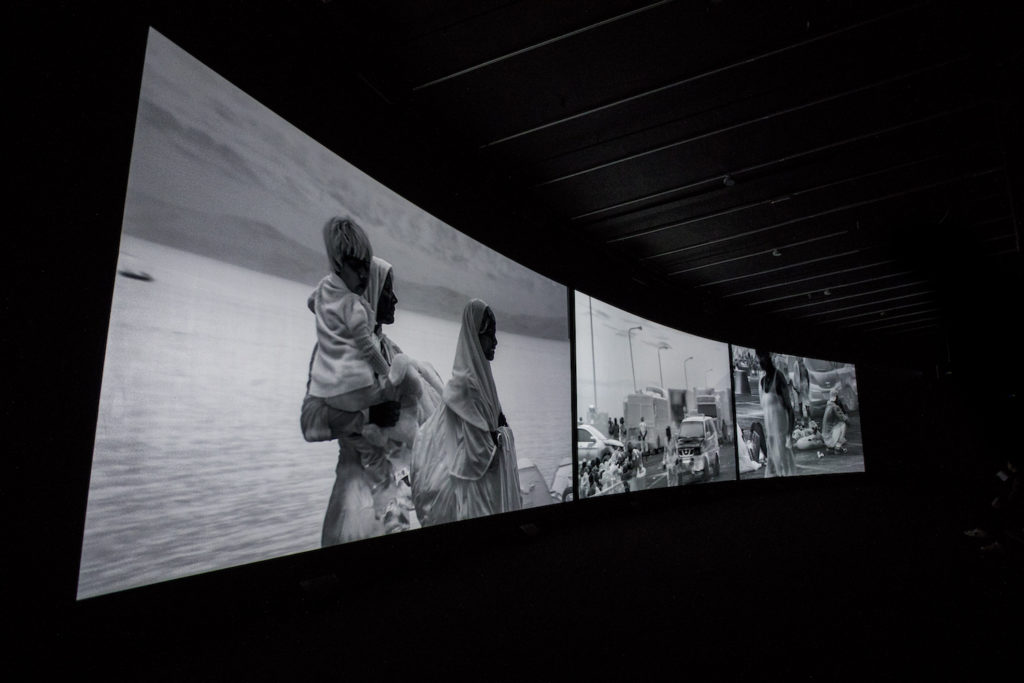
Richard Mosse in collaboration with Trevor Tweeten and Ben Frost, Incoming. Installation view at The Curve, Barbican Centre. Photo by Tristan Fewings/Getty images.
In many ways, Incoming and The Day Nobody Died could not be further apart in aesthetics and intention. Mosse elevates his 52-minute video work into an in-your-face installation that’s so aware of its authority over viewers that it’s almost soul-crushing. Curving around the Barbican’s wavy wall and split across three 12-foot screens, the uncanny, demanding film is impossible to take in all at once. The bizarre aesthetics of the heat sensor technology is weird enough. It inverts every law of physics: billowing hot smoke spurts forward like black lava, while refugee children mill around camps from Tempelhof to Calais like haggard zombies, their beady black eyes and hollow mouths making it hard to register them as human.
One of the more controversial moments of Incoming is branded as a “real-time” render of tragedy, where Mosse and his film crew are stuck helpless on a Greek island, watching and recording as a boat containing 300 refugees sinks off the coast of Turkey. They turn the thermographic camera’s roving eye on the chaotic scene; its creepy monochromatic vision precludes us from ever fully adjusting—and recognizing—the harrowing events portrayed.
While Mosse intended for this so-called “alienation effect” to reboot our perception of the refugees as humans, the disorientation it operates through can prevent us from registering these scenes as reality. Mosse’s work is a stinging critique of the world powers—particularly the US military—responsible for creating the dehumanizing technology that perpetuates such crisis. It also offers viewers an extremely rare glimpse into this sick perspective. But by co-opting this technology and turning it back on itself, Incoming faced criticism for getting too cozy with its source, effectively extending the military’s brutal gaze.
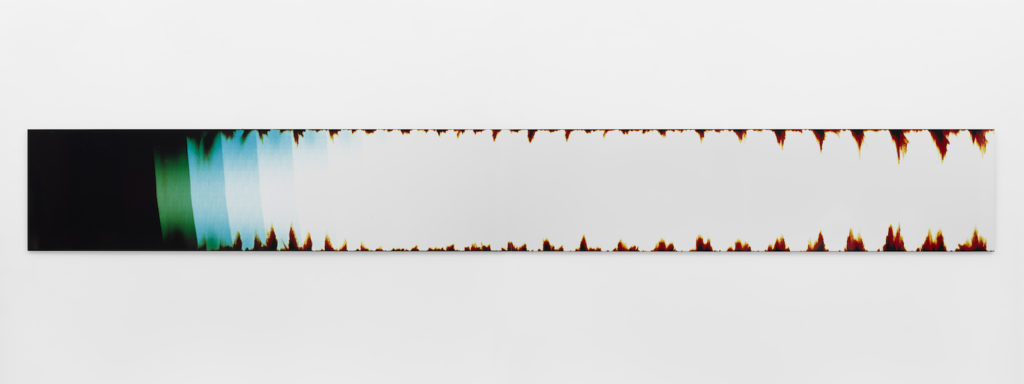
Broomberg & Chanarin, The Day Nobody Died (2008). Photo ©Broomberg & Chanarin, courtesy Lisson Gallery.
Whereas Mosse’s work feels like a tingling slap in the face, Broomberg & Chanarin’s is like a wistful, velvety kiss. Mosse’s work is as relentlessly active as it is hyper-detailed; Broomberg & Chanrin’s reflects and abstracts on a moment—and a miracle—lost to time. In 2008 the duo visited Afghanistan during the peak of the war, bearing witness to an endless montage of death and destruction—except for the fifth day, when nobody died. It was a profound pause to the chaos, which the artists compare to the calm eye of a storm. They chose to document this cathartic pause of a non-event, unravelling a six-meter roll of film to expose to the sun for 20 seconds. It was then stowed away and shipped from one military base to another, transported by helicopters, jeeps, and tanks, the information blank of its contents blissfully unknown.
Broomberg & Chanarin’s “evacuation of content” works as a foil to Mosse’s hyper-visionary Incoming. The Day Nobody Died offers a total eclipse of the standard shock imagery of warfare, instead offering a sublime abstraction of a non-moment. The viewer has no opportunity to witness, and subsequently forget about, harrowing documentation of the artists’ trip. Instead, they are haunted by its absence. The silky seductive ombré of the film’s light leak nonetheless serves as a memorial tomb to the trauma of its context—and not just in its dimensions, which mirror a standard grave.
Beyond replicating or eclipsing the visual language of trauma, Thompson’s autoportrait veers sideways, creating a “sister image” of Diamond Reynolds in the wake of the fatal shooting of her partner by a police officer at a stoplight in Minnesota last summer. autoportrait uses the preciousness of 35mm black-and-white film as a counter to the jarring, low-res imagery that defines the aesthetics of black death in the media, typically recorded on cell phones or other handheld devices. It also responds acutely to the timeline of the tragedy as an event in process: Reynolds and Thompson met to record the work at the height of the trial, and the exhibition opened, heartbreakingly, a week after the police officer was acquitted of all charges.
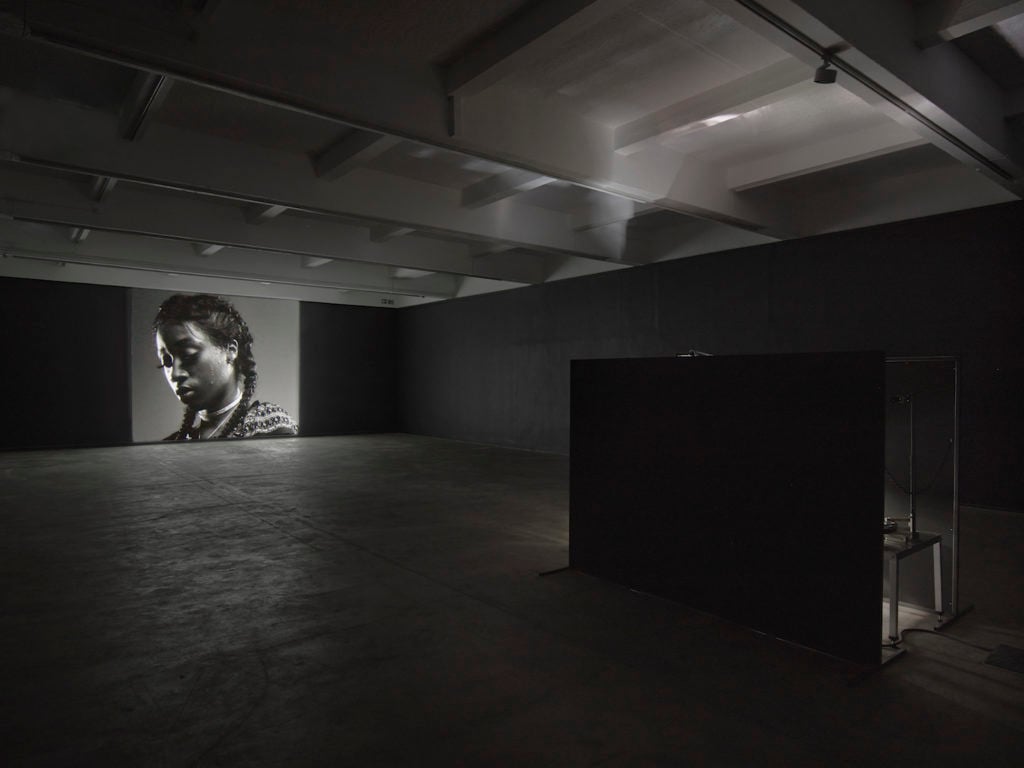
Luke Willis Thompson, autoportrait (2017). Installation view, Chisenhale Gallery 2017. Commissioned by Chisenhale Gallery and produced in partnership with Create. Courtesy of the artist. Photo: Andy Keate.
The film is at once everything the original “sister image” is not: slow, mediated, meditative, consensual, and sublime. The clattering film projector—a hulking beast situated at the back of the Chisenhale’s cavernous space—is an ode to a tradition of art history that has been split open and shook up by the everyday real world trauma of black death. autoportrait also stretches beyond these hallowed halls, unfolding more layers of meaning as the world continues to react to and process this unfinished event.
Across these different attempts to navigate the visual language of crisis, a common theme of collaboration emerges. This extends beyond the peripheries of the art world and dips, head-first, into the traumatic event in question, as much a place, like for Mosse and Broomberg & Chanarin, as a person, as for Thompson and Reynolds. Perhaps it is because this multiplicity of perspectives allows for just the right level of abstraction to re-imagine the traumatic or violent image. Or maybe it is because Mitchell’s pictures, in their ability to affect us, become effective in turn: both impressionable and sticky, binding us to each other in imagining an alternative future.